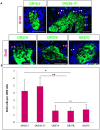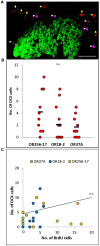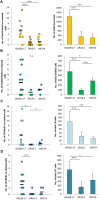Adult Born Periglomerular Cells of Odorant Receptor Specific Glomeruli
- PMID: 29692711
- PMCID: PMC5902569
- DOI: 10.3389/fnana.2018.00026
Adult Born Periglomerular Cells of Odorant Receptor Specific Glomeruli
Abstract
The OR37 subsystem is characterized by a variety of unique features. The odorant receptors (ORs) of this subfamily are selectively tuned to specific ligands which are supposed to play a role in social communication. OR37 expressing sensory neurons project their axons to a single receptor specific glomerulus per bulb which have been shown to be unusually stable in size and to possess a distinct repertoire of periglomerular cells. Since the neuronal network surrounding glomeruli is typically modified by the integration of adult born neurons, in this study it was investigated whether the number of adult born cells might be different for OR37 glomeruli compared to other OR-specific glomeruli. Towards this goal, 23 days after BrdU injection, BrdU labeled cells in the proximity of OR37A glomeruli as well as around OR18-2 and OR256-17 glomeruli were determined. It was found that the number of BrdU labeled cells in the periglomerular region of OR37A glomeruli was significantly lower compared to glomeruli of the other OR types. This finding was in line with a lower number of neuroblasts visualized by the marker protein doublecortin. Double labeling experiments for BrdU and marker proteins revealed that despite a relatively high number of calretinin expressing cells at the OR37A glomeruli, the number of cells co-stained with BrdU was quite low compared to other glomeruli, which may point to an individual turnover rate of this cell type for different glomeruli. Together, the results of the present study support the notion that the neuronal network at the OR37 glomeruli is less dynamic than that of other glomerulus types. This indicates a specific processing of social information in OR37 glomerular networks.
Keywords: BrdU; OR37; adult neurogenesis; doublecortin; glomeruli; olfactory bulb; periglomerular cells.
Figures




Similar articles
-
Structural Features of an OR37 Glomerulus: A Comparative Study.Front Neuroanat. 2017 Dec 18;11:125. doi: 10.3389/fnana.2017.00125. eCollection 2017. Front Neuroanat. 2017. PMID: 29326560 Free PMC article.
-
Activation of the mouse odorant receptor 37 subsystem coincides with a reduction of novel environment-induced activity within the paraventricular nucleus of the hypothalamus.Eur J Neurosci. 2015 Mar;41(6):793-801. doi: 10.1111/ejn.12838. Epub 2015 Jan 24. Eur J Neurosci. 2015. PMID: 25619114
-
Untypical connectivity from olfactory sensory neurons expressing OR37 into higher brain centers visualized by genetic tracing.Histochem Cell Biol. 2012 May;137(5):615-28. doi: 10.1007/s00418-012-0919-2. Epub 2012 Feb 1. Histochem Cell Biol. 2012. PMID: 22294261
-
How simple is the organization of the olfactory glomerulus?: the heterogeneity of so-called periglomerular cells.Neurosci Res. 1998 Feb;30(2):101-10. doi: 10.1016/s0168-0102(98)00002-9. Neurosci Res. 1998. PMID: 9579643 Review.
-
Axonal wiring in the mouse olfactory system.Annu Rev Cell Dev Biol. 2006;22:713-37. doi: 10.1146/annurev.cellbio.21.012804.093915. Annu Rev Cell Dev Biol. 2006. PMID: 17029582 Review.
References
LinkOut - more resources
Full Text Sources
Other Literature Sources

